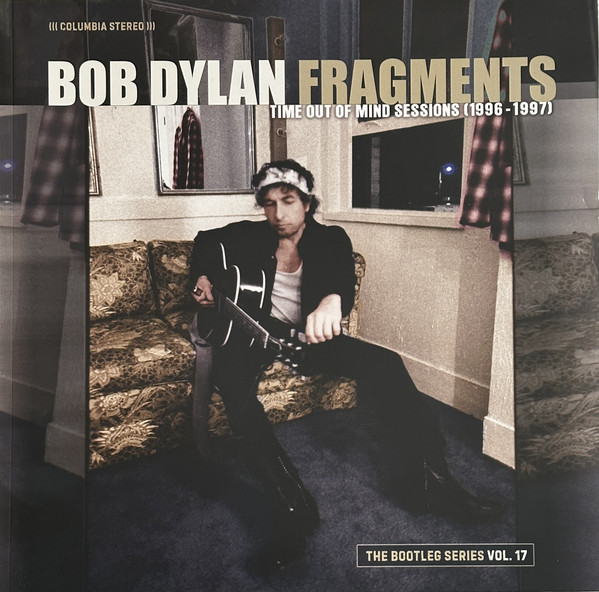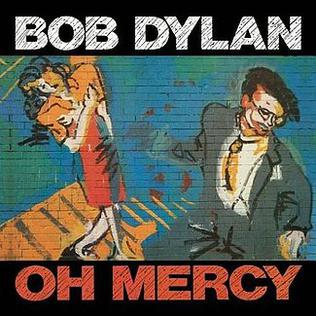Seven whole years had passed since the last real Dylan album. In contemporary interviews, Bob said that for the longest time he just didn’t feel like writing songs, then was suddenly able to come up with a batch while being snowed in. Then he was hesitant to play them on tour for fear of having them bootlegged, and wanted to do them justice in the studio as well. So he spent a few weeks in Miami recording with some of his then-current touring band, a few session hotshots including the stalwart Jim Keltner, and
Daniel Lanois, who produced
Oh Mercy, and the album was in the can.
Naturally, there was a certain amount of anticipation and absolute fear upon the announcement that something new was finally on the way; meanwhile, the news of a potentially fatal heart ailment between recording and release brought decent PR to the event. Anyway, we needn’t have worried.
Of the eleven phenomenal tracks that make up Time Out Of Mind, half are based around the 12-bar blues form. Most deal with some unnamed woman (or women) who broke Bob’s heart in a big way, and boy, is he miffed about it. The production is pretty swampy, slapping a lot of echo over his voice, which was pretty shot anyway; he doesn’t try to hit any high notes, which in the past resulted in a lot of yelling on his part.
A quiet stomp and a bleating Vox organ opens “Love Sick”, taken very slow and sounding like he’s transmitting from Mars. A little more upbeat, “Dirt Road Blues” effectively emulates an old 78 but still maintains the spooky vibe. The album’s first masterpiece is “Standing In The Doorway”, another slow, slow song with wonderful imagery, each verse more heartbreaking than the last. “Million Miles” continues the blues theme, his voice a perfect match for the words, and we start to hear some of the dad jokes that will begin to pepper his lyrics (“gonna find me a janitor to sweep me off my feet”). “Tryin’ To Get To Heaven” provides a nice break in the form of a major key and a memorable melody that belies the fatalistic words; there’s even a harmonica solo. “‘Til I Fell In Love With You” doesn’t take hold as easily, but there’s some incredible imagery here. “Not Dark Yet” could be taken as another rumination on his own mortality, played in a style that links well to the better songs on Oh Mercy.
That’s practically a full album right there, but we’ve got a ways to go. The trip to hell continues on the downright scary “Cold Irons Bound”—that’s meant as praise, by the way—with the atmosphere dominated by Augie Myers on the Vox organ, to which the extra-gentle “Make You Feel My Love” provides welcome calm. While beaten to the charts in versions by both Billy Joel and Garth Brooks, this one, with Bob up front on piano, is still the template. “Can’t Wait” is another blues taken at a funereal pace, but keep an ear out for a killer two-line bridge. That’s a mere setup for the fascinating 17-minute journey of “Highlands”, which closes the album. The first few verses could be a song on their own, but he throws in a shout-out to Neil Young, then ends up in a restaurant sparring with a waitress over art and literature. (And really, how could it be that any eatery “ain’t got any” hard boiled eggs?) The final set of verses could qualify as a separate song too.
We knew he could do it again, and we’re glad he did. Basically, he waited until he had something to say, then said it. It went on to win a few Grammys, and even staunch Dylan haters were overheard saying it’s not that bad an album. Time Out Of Mind heralded a new era for a man who insisted he hadn’t gone away in the slightest. He’d had an actual near-death experience, and he was still out there—just a simple song and dance man.
While some of the outtakes were featured on
the eighth Bootleg Series volume, the album eventually got its own installment in the series, kinda sorta in honor of its 25th anniversary. One disc of
Fragments was devoted to a new mix of the album that stripped away some of the sonics Lanois took credit for to bring out more of the room, while another offered outtakes and alternates, starting with a lovely take on “The Water Is Wide” and the sadly shelved “Red River Shore”. “Can’t Wait” has a more melodic guitar part and different lyrics, and the spontaneous applause at the end of “Make You Feel My Love” is just charming. There’s yet another version of “Mississippi” that comes closest to
the version he’d finally nail, and other songs with more upbeat arrangements than what was released.
That was fine, but a deluxe version added three more discs. One devoted to live versions—some from actual audience tapes, as befits a “bootleg series”—presented each of the album’s songs, mostly in the original track order, with “Can’t Wait” used twice because “Dirt Road Blues” has apparently never made it to the stage and “Mississippi” included just because. Further outtakes and alternates included an intriguing but still inferior “Dreamin’ Of You”, another “Marchin’ To The City”, “‘Til I Fell In Love With You” played as a samba, and “Can’t Wait” notable for a surprising Dylan yelp before the first verse. Most controversially, a fifth disc repeated the session outtakes and two live versions already included on that earlier Bootleg Series set. This wasn’t even done covertly—it was highlighted on the sticker on the shrinkwrap. Still, they fill in the bigger picture, even with multiple takes stacked together. (Also, each disc was packed nearly to capacity, each exceeding 70 minutes.)
Bob Dylan Time Out Of Mind (1997)—5
Bob Dylan Fragments: Time Out Of Mind Sessions (1996-1997)/The Bootleg Series Vol. 17 (2023)—4
 While fans were accustomed to Peter Gabriel’s slow release pace and interest in world music, they were clamoring for the true follow-up to So. With Us, chock full of songs built on hooks, they got it.
While fans were accustomed to Peter Gabriel’s slow release pace and interest in world music, they were clamoring for the true follow-up to So. With Us, chock full of songs built on hooks, they got it..png)

.jpg)













.jpg)